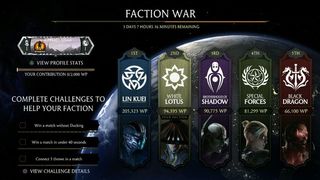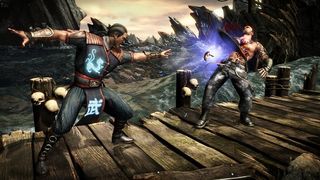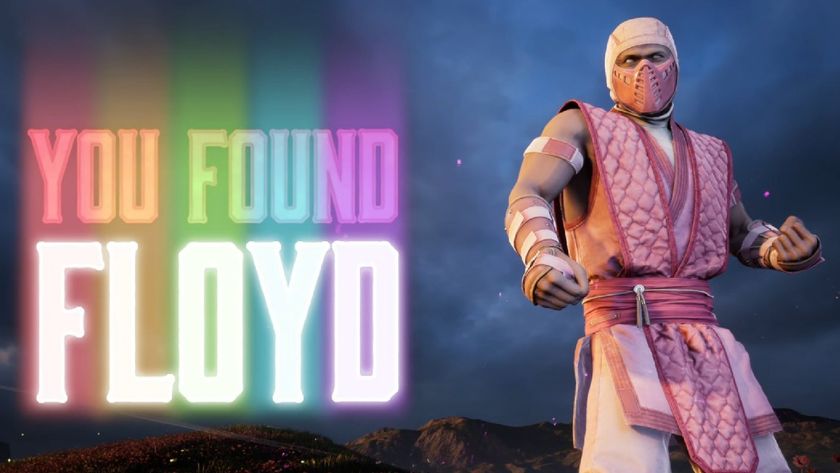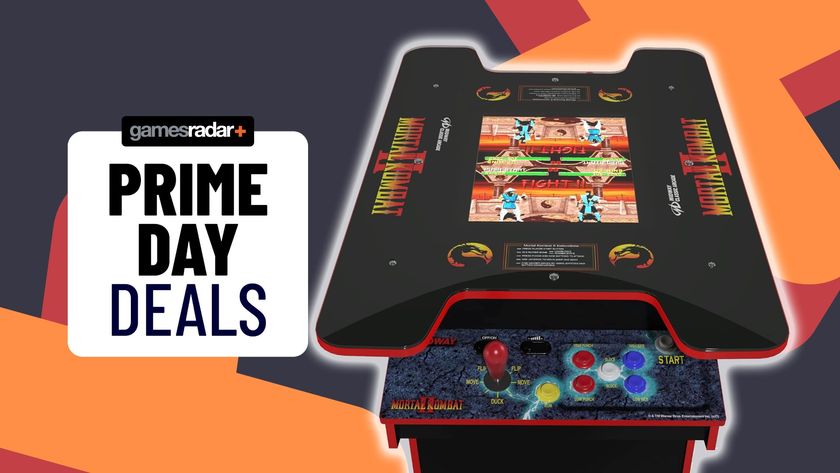Mortal Kombat X is the Destiny of fighting games, and that's very smart
‘Long-term significance’. That’s the phrase that came up again and again during our only occasionally furious Game of the Year discussions toward the end of 2014. It wasn’t enough for a game to just be good. In order to be in with a shot at the big title, candidates had to exhibit some kind of vital relevance; they had to sum up where the cutting edge of games is right now, and present the kind of design we knew we’d see cloned a whole bunch of times over the following 18 months.

That, amongst other factors - including over 1000 combined play hours accrued by the team (and growing) – was why Destiny was the only arguable winner. I felt 100% assured that we’d made the right decision. In fact I just plain knew we had. What I didn’t know though, was that I’d be seeing the first, concrete confirmation of that rightness just over a month later. You see, the first ripple of Destiny’s influence has turned up, entirely unexpectedly, in Mortal Kombat X. Honestly. This isn’t just my Bungie-addled brain talking here, seeing Hive in every shadow and thinking every cloud looks like a Fallen Spider-Tank. Some of them look like Bill Nighy, for instance.
No, this is legitimate, obvious, try-really-hard-to-pretend-you-hadn’t-noticed-when-talking-to-the-dev, cross-pollination of a new idea. And I’m really rather excited about it, not just in terms of its potential in Mortal Kombat X, but in terms of the future evolution of console gaming in general over the next couple of years.

In terms of MKX specifics, what we’re looking at is the new game’s smarter, more dynamic, online-enabled reworking of MK 2011’s excellent Challenge Tower mode. The previous version delivered 300 off-kilter fighting challenges tweaked with a dizzying array of mods – from endurance matches, to customised health and damage settings, to specific move and finisher demands, and more – and was, at the time, one of the fighting genre’s most creative solutions to the problem of solo play. In MKX though, things have been scaled up to offer a much fuller, more dynamic, new-gen experience.
Where does Destiny come into it? The model being used in Netherealm’s upcoming limb-removal sim has serious echoes of Bungie’s Daily, Weekly, and Weekly Nightfall challenges. For the uninitiated, those are – respectively - curated story missions and Strikes, modded for differing gameplay experiences on the fly, as well as player and enemy buffs and debuffs. They’re updated live at the frequencies suggested by their names, and their ascending difficulty and appropriate rewards (Nightfalls force a full restart if your whole team wipes, but give a week-long XP boost if completed), have become the community’s default, ‘canon’ way to level up later in the game.
They’re great, providing regular, standardised, and – crucially - economical, streamlined routes to progression. That they also, by default, mix up the gameplay is a primary means by which Destiny adds more gratifying meaning to its high-level gear and abilities.

As for MKX? There are now three live, online, Living Towers, one that reboots every two hours, one that updates daily, and a bigger, harder, longer-term Premiere one. All will be curated and updated at different frequencies, and all will be modded for differing gameplay experiences on the fly. Rewards will be appropriate to their ascending difficulty, and there’s every chance they’ll be a primary means by which Mortal Kombat X adds more gratifying meaning to its high-level, solo play. And where Destiny has long-term levelling, gear development, and Bounty challenges, MKX has Faction War, another weekly event in which players aligned to in-universe groups are judged according to special tasks completed. Again, there are weekly rewards and for the winning faction.
Sign up to the 12DOVE Newsletter
Weekly digests, tales from the communities you love, and more
On the surface of it, all of this stuff is just a great new addition. Having played offline versions of all three Living Towers recently, I can confirm that they’re a bomb-dodging, laser-jumping, lightning-wrangling hoot. But looking at the bigger picture, their genre-shifting adaptation of Destiny’s example is a really heartening sign of the way developers are starting to think about new-gen console gaming. In short, it seems that – after a year or so of rereleases and slightly prettier cross-gen games – devs are finally starting to think in terms of their games doing something new.

Because a new console generation doesn’t start with new boxes and shiny, polygon-pounding launch games. It starts at the point when the ideas in games change, the extra horsepower and hardware versatility having a real, tangible effect on the ways developers think about what games can be.
Until recently, I haven’t felt like that was happening much with the PS4 and Xbox One. Old favourites have looked nicer, and known franchises have (usually) run better, but for the longest time I was still waiting for what I call ‘the BioShock moment’, the point when ambitions and design philosophies take a step up and initiate a new set of standards to lead the mainstream over the next few years.
I’ve always felt that Destiny – with its insightful, streamlined, console delivery of the PC MMO experience, and its adaptation of the FPS into a persistent, evolving journey punctuated with very personal attachment – would be influential, but seeing a game as radically different as Mortal Kombat pick up the baton has put a great big smile on my face.

Let’s face it, the fighting game, for all of its eclectic development over the last 30 years, is one of the genres most constrained by its format. Two characters on screen, a closed arena, health bars, lots of hitting until someone falls over. Those are the limits it has to work inside. So how do you deal with that? Do you rely on a gimmick? MK started that way 23 years ago, but that’s not an option in 2015. Do you get ultra-complex and push for pure technical depth? Capcom tried that with Street Fighter 3, and lost the masses instantly.
But this third way, this ‘bigger picture’, new-gen way, concerned more with wider context than tweaking the basic building blocks of design, is smart. Without making any overly drastic changes to the series’ core gameplay, it nonetheless looks to amplify the experience delivered by that gameplay, turning familiar actions into a much bigger, more nourishing, more compulsive, long-term path, whether other players are around or not. Just like Destiny did with Halo’s shooting.

Do I expect every game to be built around persistent, online challenges and rewards in a year’s time? No. In fact I don’t even want that, not specifically. But I do see what’s going on here as an exciting step in the right direction. Whatever the concrete details end up being, it seems stalwart developers have now started thinking of their games in a conceptually wider fashion, and that’s what I think we’re going to see a lot more of from now on. I hope so. Because that’s how a new generation really starts.
Most Popular








